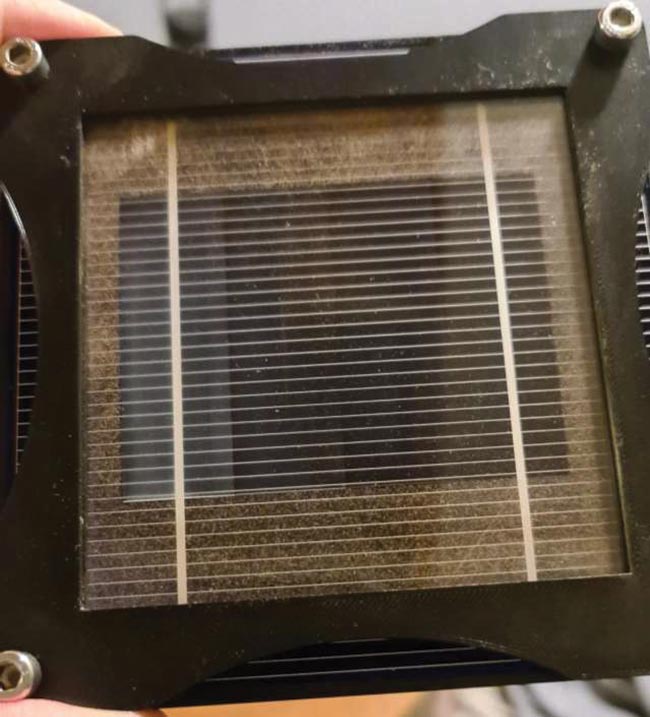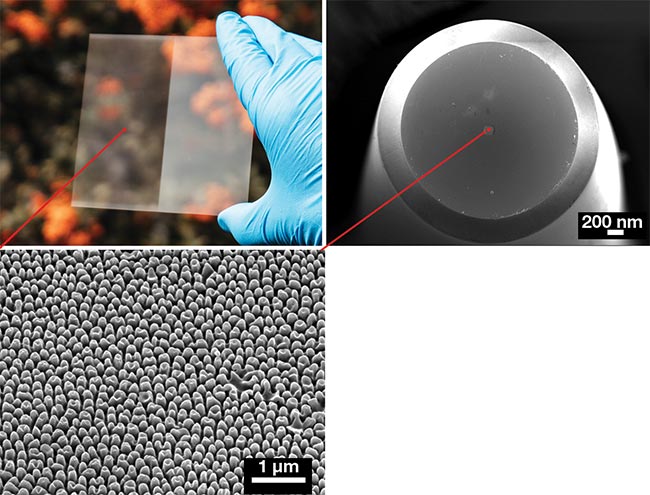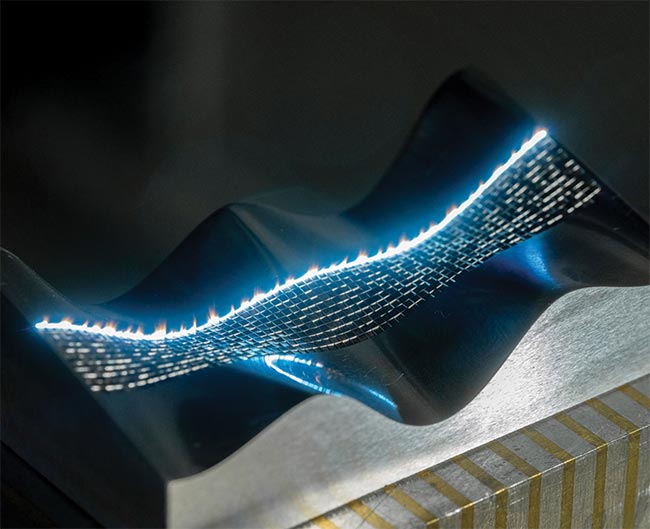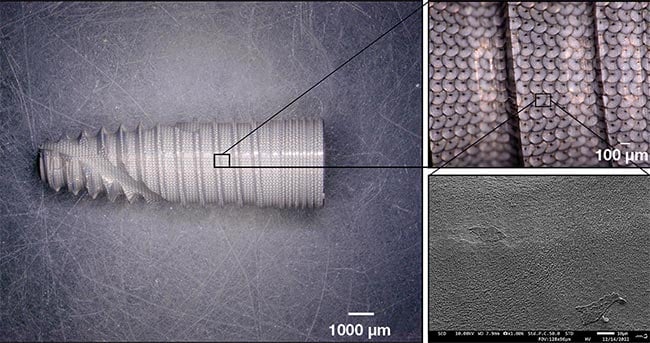ANTONIO CASTELO EUROPEAN PHOTONICS INDUSTRY CONSORTIUM (EPIC)
Surface texturing is a method used to produce a specific pattern or texture on a surface to change, improve, and/or enhance the properties of certain materials. The process of generating new or different properties is called surface functionalization, which modifies not only the optical characteristics of a surface but also the surface’s mechanical resistance, friction, adhesion, or wettability. This technology has attracted the attention of the life sciences and medical industries because it has forged new ways to manufacture parts with self-cleaning surfaces or antibacterial functions and has improved the biocompatibility of medical components and implants.
Several techniques have been used to create new surface textures, including chemical etching, sand blasting, and the application of coatings. Each technique presents its own disadvantages that typically arise from the adverse effects of chemicals or physical contact with the material itself, or from the special environments or cleanrooms required to process the surfaces.
Laser-based surface functionalization has more recently appeared as an appealing alternative to earlier methods of surface texturing. Due to its high speed, controllability, and efficiency, it is a widely used noncontact technique. Laser surface functionalization is also incredibly precise and allows for the creation
of micro- and nano-scale features over large areas.
The development of ultrafast laser sources, scanning heads, beam-shaping solutions, and integrated systems has helped introduce laser surface functionalization to a number of new applications and end markets. Several companies have taken advantage of these new solutions to develop specific technologies.
Companies such as Fusion Bionic in Germany and Biomimetic in Crete, for example, are using different techniques
to design and manufacture biomimetic surfaces — based on features and functions inspired by nature — to improve the performance of different materials. Naturally occurring examples of functional surface structures with beneficial properties include the lotus leaf’s response to water or the reflectance characteristics of the eyes of certain moths.
Nature-inspired, human-made
Both Fusion Bionic and Biomimetic have replicated such surface functionalities using laser sources. The former uses the direct laser interference patterning technique, which works by overlapping laser beams on the substrate to generate an interference pattern, creating a microstructure on the substrate’s surface.
Fusion Bionic has developed compact and versatile laser modules that allow the
direct laser interference patterning process to apply to almost any technical surface as well as to many shapes with speeds of up to 3 m2/min, with sample sizes currently up to 1500 × 1000 mm2. To accelerate the uptake of laser functionalization, Fusion Bionic is operating an application center that is focused on developing biomimetic surfaces and providing related contract manufacturing
services.
The company has applied its technique in the consumer goods and electronics
industries, in which it has improved the visibility and transparency of some materials by creating antireflection and antiglare surfaces.
Fusion Bionic has also been very active in the photovoltaic industry, in which
surface functionalization technology could help to manufacture self-cleaning photovoltaic panels and cells with anti-soiling surfaces. This would address the reduction of photovoltaic power production that derives over time due to the accumulation of mineral dust, bird droppings, pollen, or engine exhaust in their active surfaces (Figure 1).

Figure 1. A contamination-free photovoltaic demonstrator based on Fusion Bionic’s laser texturing technology. Laser surface functionalization technology could enable self-cleaning photovoltaic panels and cells. Anti-soiling surfaces would maintain power production over longer periods by resisting the accumulation of mineral dust, bird droppings, pollen, or engine exhaust. Courtesy of Fusion Bionic.
Meanwhile, Biomimetic has focused on developing its Tettix process, a selective low-cost turnkey laser treatment that is applied directly to glass and crystalline substrates. The process eliminates surface reflection while enhancing transmissivity for wavelengths in the visible and infrared spectrums at various angles of incidence.
Biomimetic can also combine high-performance, antireflective characteristics with antiglare properties. The company has achieved surfaces with a controllable haze and scattering properties that demonstrate an average reflection of <1% and high transmittance >99.5% for visible and infrared wavelengths. They have applied this technology to electronic displays, optical components, and even fiber optics (Figure 2). Furthermore, its nanotextured glass surfaces exhibit an increased light-induced damage threshold and contribute to developments in high-power laser and space applications.

Figure 2. Biomimetic applications in glass, including antireflective, antiglare, and antifogging surfaces. Courtesy of Biomimetic.
Another innovative capability of Biomimetic’s Tettix laser treatment is the combination of antireflective, antifogging, and superhydrophilic properties, which has enabled reflectivity of <1% and a permanent water contact angle <10º. The superhydrophilic nature of the treated glass substrates shows promise for microfluidics and optical covers.
Speeding femtosecond throughput
A factor that has limited broader industrial implementation of laser surface functionalization is the low process speed when retexturing large surface areas with femtosecond lasers. This issue is exacerbated for applications that require the laser to texture a sufficiently large surface area for the benefits to be conducive.
Different studies have been conducted to overcome this limitation. For example, Fluence sp. z o.o., based in Warsaw, Poland, has demonstrated increased productivity in laser nanopatterning systems for stainless-steel surfaces using its Jasper X0 laser and a top-hat beam shaper.
The company achieved efficiencies of 22.8 cm2/Wmin, which is comparable with the results obtained using polygon scanners or multibeam diffractive optical elements. Thus, covering the surface of the steel with nanoripples <1 µm can be done as quickly as 1300 cm2/min. Such fast marking is potentially useful for creating textured surfaces on molds to induce superhydrophobic or antibacterial properties on the molded parts.
Fluence sp. z o.o. has also analyzed the effect of pulse width and laser wavelength in the ablation of micrometric patterns on the surfaces of metallic molds. Ablation efficiency and process throughput can be significantly improved using optimum
laser fluences and pulses <250 fs.
Fluence has obtained ablation efficiencies of 0.31 mm3/Wmin in stainless steel using a fiber laser at three different wavelengths: 1030, 515, and 343 nm. By employing 250-fs pulses, the processing speed was shown to improve by 100% compared to picosecond pulses. In addi-
tion, operating the laser in burst mode increased the ablation rate by a factor of 2.6 compared to single pulses. Burst mode also helps to employ higher laser powers while keeping high spatial resolution (small spot sizes).
This is a difficult task due to the normally low optimum fluence for the
ablation of metals, which is typically
<0.3 J/cm2. The maximum removal rate
at the 30-W average power of Fluence’s Jasper X0 laser — providing surface roughness Sa (the arithmetical mean height) is <1 µm — can be as high as
8.8 mm3/min for stainless steel type 1.4301 and 11.7 mm3/min for titanium Ti6Al4V alloys. Further, maintaining a
superior surface quality for the steel — with Sa <0.3 µm — and high process
efficiency can be obtained when operating the laser at 343 nm.
Texturing polymers and shapes
Various laser wavelengths have been explored to help improve surfacing results in nonmetallic materials. The Canadian-based company Femtum has focused on developing ultrafast mid-infrared fiber lasers with wavelengths >2800 nm, which the company has successfully used to texture polymer surfaces to improve
mechanical, thermal, and adhesion properties.
Many plastics and polymers present high transmission, ~1 µm, which either reduces the efficiency of a laser’s ability to process material at that wavelength or requires the use of additives to improve the material’s processability. These same polymer materials, however, absorb laser energy particularly well in the mid-infrared, resulting in localized heating and improved ablation of the material as well as the generation of controlled surface features. Femtum has been working in this range of the spectrum to optimize laser tools for processing plastics and polymers.
The developments of the laser sources must be combined with the improvements to positioning systems to satisfy the demands of large-area surface functionalization. The Barcelona-based company Microrelleus, S.L. has taken advantage of femtosecond laser machines developed elsewhere to provide surface texturing services to its customers. Among its equipment is a new machine with five
mechanical axes and three optical axes that allows for the processing of workpieces weighing up to 1200 kg. The system design gives unprecedented process control to allow for improved accuracy of the textures that they implement in different materials (Figure 3).

Figure 3. Surface texturing a complex shape using a five mechanical axis laser machine. Combining femtosecond laser technology with advanced motion control is enabling unprecedented accuracy when texturing the surfaces of different materials. Courtesy of Microrelleus.
Medical applications
As mentioned earlier, the biotech and medical industries have both shown an increased interest in the ability of laser texturing solutions to benefit their products. One beneficial application in this space is the modification of the surface of medical implants, which helps guarantee their biocompatibility and integration with tissue. In addition to the precision and reproducibility of laser resurfacing processes, another key advantage is that these processes do not leave the surface contaminants that are common with other techniques. Such contaminants require additional postprocess cleaning steps that increase the overall fabrication time and cost of implants.
Experts in multiscale surface functionalization at France’s Manutech USD group are participating in the European LaserImplant project to modify the surface of medical implants to control cell adhesion. The project focuses on dental prostheses, in which implants consisting
of titanium or a titanium alloy must be capable of fast osseointegration into the jawbone. In the case of bone screws and plates, these implants might have to
be removed after some time and should not be completely overgrown by the
tissues. Within the LaserImplant project,
Manutech USD has been developing new laser-induced micro- and nanostructures to enable control of both cell adhesion and repellence on implants (Figure 4).

Figure 4. A dental implant textured with doughnut shapes for improved bone adhesion. Courtesy of Manutech.
Fusion Bionic has been working on a different set of biomedical applications. After exploring laser texturing to improve the biocompatibility of medical implants, the company applied
its direct laser interference patterning process to create
microtextures that
increased the adhesion of cells (osteoblasts) to implant surfaces. They have proved that laser microtexturing is a suitable substitute for sandblasting as a prerequisite step before applying biocompatible coatings.
They have also explored the possibility of developing antimicrobial textures for medical surfaces, or textures that improve antimicrobial function. Titanium implants that were functionalized through direct laser interference patterning showed a lower bacterial adhesion of ~30% in E. coli during pre-studies. Submicrometer textures that were fabricated on polymers showed a significant decrease in the
bacterial adhesion of both S. epidermidis
and E. coli. Fusion Bionic’s surface texturing process has also demonstrated an improvement in the mechanical properties of medical components, such as tailoring
wettability, increasing the adhesion of coatings, and reducing the friction for scalpels and the directional friction on catheters.